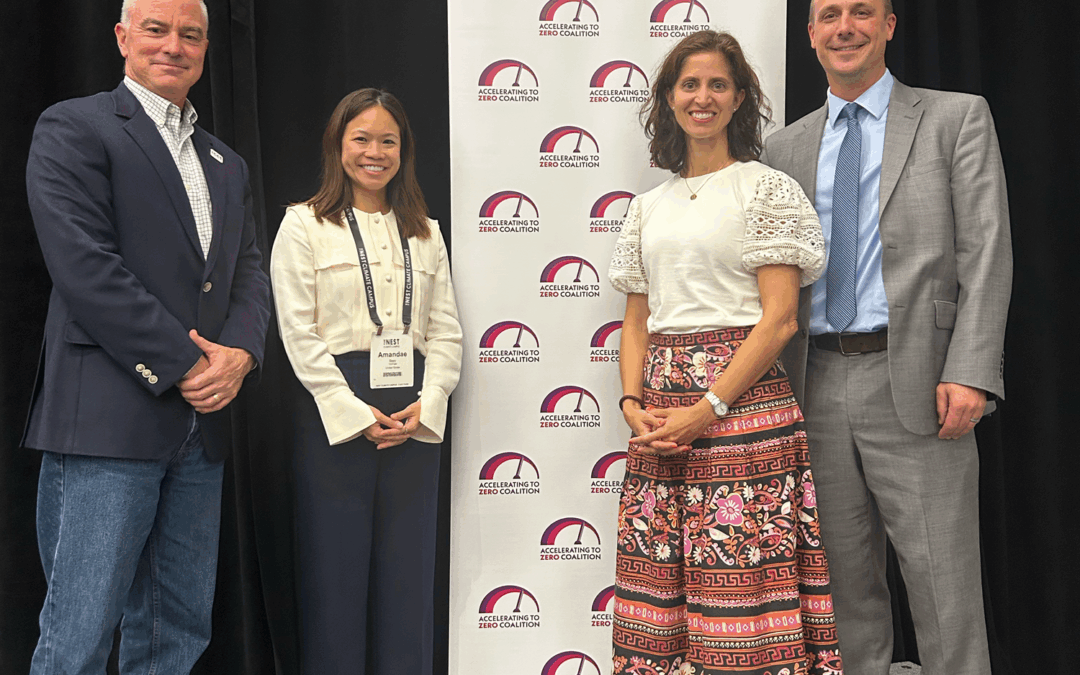Drew Kodjak, President & CEO of the International Council on Clean Transportation, stands with Amandae Baey (Vinfast), Vanessa Butani (Volvo), and Adam Orth (Siemens).
As the window for climate action continues to narrow, the momentum towards zero-emission vehicles (ZEVs) is only accelerating. During this year’s Climate Week NYC, the Accelerating to Zero Coalition brought together state leaders and corporate executives of ZEV Declaration signatories to showcase their progress in the ZEV transition, demonstrating that despite federal uncertainties, the electric future is within sight.
Katie White, newly appointed Minister of Climate for the United Kingdom, opened the event with a positive outlook on the future of the ZEV transition. “The science could not be clearer,” she said. “Our window of time to take meaningful action is closing rapidly.”
While calling on new signatories to take the pledge towards an electric future, she welcomed the diverse voices and perspectives of those who have already signed to champion the pivotal role they’ve played in this transition.
State leadership in the face of federal uncertainty
State leaders from California and Washington took center stage to discuss their strategies to defend against potential federal rollbacks of climate policies. Rather than ceding ground on longstanding environmental leadership, these states are doubling down on their ZEV commitments. Across the two states, 1 in 5 light-duty vehicles sold is electric, symbolizing that consumer demand has not wavered.

Secretary for California’s Environmental Protection Agency (CalEPA), Yana Garcia, stressed the importance of a coordinated approach to combatting federal challenges. Through initiatives like the US Climate Alliance, which recently launched the Affordable Clean Cars Coalition in partnership with 13 governors, California is committed to sharing its knowledge across the country.
“We know not every jurisdiction has the resourcing to recalibrate its programs, or go on the offensive,” Yana reflected. “So, it falls to us to foster these coalitions for states with less robust climate policies.”
In Washington state, which recently saw some of the highest gas prices in its history, Casey Sixkiller, director of the Department of Ecology, reminded the audience that combatting negative narratives around ZEVs is vital to adoption. They’re proactively addressing concerns by presenting data-driven arguments that will resonate with residents. Washington’s recently launched ZEVergreen initiative exemplifies this approach, focusing on combatting fears around range anxiety and affordability through charging corridors that serve both rural and urban communities.
“During these challenging political times,” said Casey. “Having state leaders who are courageous and committed to making progress is incredibly important.”
Corporate commitment drives innovation
The next panel discussion featured three corporate ZEV Declaration signatories at different stages of their electrification journeys, including Vanessa Butani from Volvo Cars, Amandae Baey from VinFast, and Adam Orth from Siemens. Their conversation revealed both common themes and unique perspectives on market transformation.
Regional adaptation strategies emerged as a common and critical success factor. Each speaker emphasized that a one-fit-all approach won’t work in a global context. For Volvo, the company recently adjusted its electrification goal to reach 90-100% by 2030 – in 2024 they hit 46% – but their regional strategies use plug-in hybrid electric vehicles as a bridge technology. “This will be particularly important in the United States,” Vanessa noted, “where the transition timelines may be extended.”
For VinFast, their impressive domestic growth has skyrocketed them to become Vietnam’s largest automotive manufacturer in just under five years. As they now seek to enter new markets, namely in India, Thailand, Indonesia, the Philippines, and North America, a tailored approach has been key. Affordable models and free charging incentives have allowed them to break into these new geographies.
Similarly for Siemens, which represents the broader electrification ecosystem, the company is taking learnings from across different markets and applying them globally. This knowledge sharing has propelled them to electrify roughly 12,000 vehicles in their 43,000 global fleet.
Charing infrastructure also dominated the discussion, with range anxiety identified as a top consumer concern. While the speakers acknowledged infrastructure buildout remains uneven, they each emphasized that strategic partnerships are key to overcoming this challenge. VinFast has approached the challenge as a real estate game, deploying their own charging stations through their sister company V-Green across Vietnam. In other markets, partnerships with businesses that own property and utility companies are proving essential.
“It’s a here and now problem,” Vanessa said. “But the technology is improving in leaps and bounds and there are many opportunities to advance the ecosystem.”
Perhaps most critically, all speakers emphasized the need for policy stability. They agreed that maintaining electrification momentum requires governments providing consistent frameworks that allow them to invest for the long-term. It takes roughly three to four years to develop and launch a new vehicle, so inconsistent signals make strategic planning difficult.
Adam reinforced this point, saying, “while the challenges towards electrification won’t go away, how we evolve and attack those challenges will.”
This Climate Week event ultimately delivered a message of resilience and determination from all speakers in attendance. Despite federal uncertainties and persistent challenges, the electric vehicle transition is not only continuing—it’s accelerating. In these challenging times, the messages of these ZEV Declaration signatories, and the progress they’ve clearly demonstrated, offers continued hope for a cleaner, more sustainable future.

